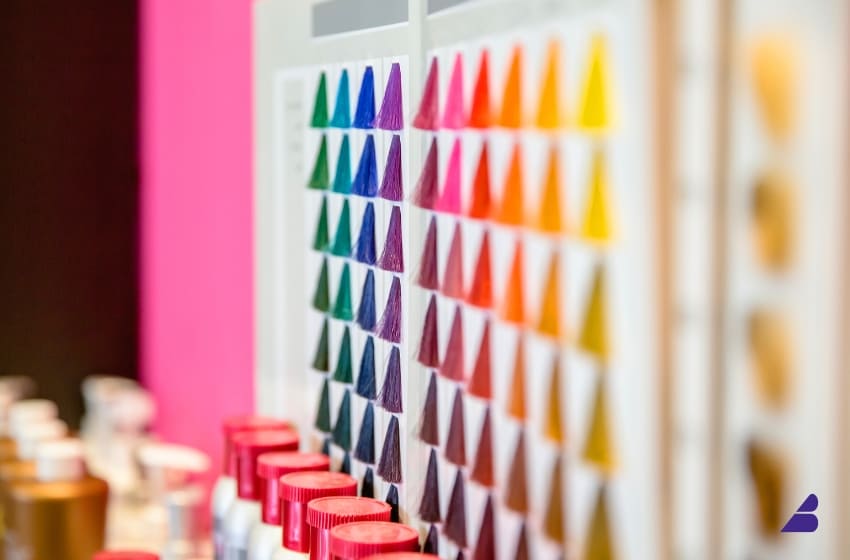
The world of branding often revolves around standard colors like red, blue, and green, but there is much more to explore in the color spectrum. Uncommon colors can create unique brand identities that set businesses apart from competitors. These less conventional colors have the power to evoke specific emotions and perceptions, influencing how consumers interact with a brand.
Understanding the psychology of color extends beyond basic associations. Subtle variations in hues can shape consumer perception and create deeper connections with a brand. By strategically using less common colors, companies can enhance their marketing strategies and more effectively resonate with their target audience.
As brands look to differentiate themselves in crowded markets, they must consider how color in branding can reflect their values and mission. This exploration of uncommon shades reveals an exciting opportunity for businesses to forge strong emotional ties with consumers and establish a memorable presence in the marketplace.
The Science of Color Psychology
Color psychology focuses on how colors affect emotions, behaviors, and psychological associations. Various shades invoke different emotional responses and can influence human behavior in significant ways. Understanding this science helps brands create effective visual identities that resonate with their audience.
Understanding Color Perceptions and Associations
Colors are linked to specific emotions and concepts. For instance, blue is often associated with calmness and trust, while red can evoke feelings of excitement or urgency. These associations stem from cultural contexts and individual experiences.

Psychological associations with color can vary across cultures. For example, white is seen as pure in some cultures but can represent mourning in others. Brands must consider these differences when designing their identity. A well-thought-out color choice can strengthen a brand’s message and connect with target audiences.
Color Psychology in Human Behavior
Color influences human behavior in various ways, including purchasing decisions and mood regulation. For example, studies show that warm colors can stimulate appetite, making them popular in restaurant branding. In contrast, cool colors often promote relaxation, suitable for spas and wellness brands.
Colors also affect psychological functioning. Bright colors can enhance energy and motivation, while muted shades may lead to feelings of calm or sadness. Brands can harness these effects by choosing colors that align with their desired image. Creating a cohesive color strategy aids in building a strong emotional connection with consumers.
Influence of Colors on Branding and Marketing
Colors play a critical role in shaping a brand’s identity and influencing consumer behavior. Through strategic use of color, brands can evoke emotions, enhance recognition, and communicate their core values to their target audience.
Arousing Emotions and Emotional Impact
Colors have the power to trigger specific emotional responses. For example, red can create feelings of excitement or urgency, making it effective for clearance sales. Blue often conveys trust and reliability, which is why many financial institutions use it to foster confidence.
When brands align their colors with the emotional responses they want to evoke, they can create a deeper connection with their audience. For instance, wellness brands may use greens to symbolize health and tranquility, while luxurious brands often lean towards rich purples or golds. Each choice sends a message that resonates emotionally with consumers.
Color and Brand Recognition
Brand recognition is significantly influenced by color. Research shows that around 62 to 90% of snap judgments made by consumers are based on colors alone. This means a well-chosen color palette can make a brand more memorable.
Major companies like Coca-Cola and McDonald’s showcase how consistent color usage enhances brand identity. Their familiar hues focus on visual appeal and help the audience instantly recognize their brand in a crowded marketplace. This strong visual identity can lead to higher consumer loyalty as people often develop preferences based on color association.
Color Palettes and Brand Personality
A brand’s color palette also defines its personality, reflecting its values and mission. For example, vibrant and bold colors suggest a dynamic and youthful brand, while muted tones can convey sophistication and tradition.
Brands often select complementary or analogous colors to create a cohesive look that appeals to their target audience. This strategic choice reinforces brand values, enhances visual identity, and ultimately shapes the consumer’s perception and experience with the brand.
By understanding the relationship between colors and branding, marketers can develop effective strategies that speak to their audience on a deeper level.
The Significance of Uncommon Colors in Branding
Uncommon colors play a vital role in shaping brand identity and appeal. By utilizing colors like purple, orange, and pink, brands can project specific emotions and attract target audiences effectively. Each uncommon shade carries unique connotations that enhance branding strategies.
Navigating Beyond Primary Colors
Many brands rely heavily on primary colors, but exploring uncommon hues like orange or purple can distinguish a brand from the competition.

Orange often signifies enthusiasm and energy, making it a suitable choice for brands focused on adventure or creativity. Purple conveys sophistication and luxury, attracting customers who appreciate high-end products.
Incorporating these colors can evoke distinct feelings, helping brands to build a unique personality in a crowded marketplace.
Luxury, Creativity, and Appetite Triggers
Colors like purple are frequently associated with luxury and sophistication. High-end brands often use this color to create an aura of exclusivity.
Orange can stimulate appetite and creativity. Restaurants and food brands that use orange in their branding may find it encourages hunger and a sense of warmth. This color is perfect for creative industries looking to inspire energetic and innovative thought.
By strategically using these colors, brands can better connect with their intended audience and enhance emotional engagement.
Psychology of Secondary and Tertiary Colors
Secondary colors such as green and purple, along with tertiary colors like teal or magenta, offer additional ways to communicate brand values.

These shades can convey a sense of balance, creativity, and fun. For example, green represents growth and renewal, appealing to eco-conscious consumers.
Meanwhile, pink evokes warmth and approachability, suitable for brands aimed at younger demographics or those focused on inclusivity.
Utilizing this broader color spectrum allows brands to craft their identity and influence consumer perceptions more effectively.
Cultural Variations and Personal Experiences in Color Interpretation
Colors carry different meanings and feelings depending on cultural backgrounds and individual experiences. Understanding these variations is key for effective branding and communication.
Color Perceptions Across Different Cultures
Cultural backgrounds greatly influence how individuals interpret colors. For instance, in many Western societies, white symbolizes purity and is often used in weddings. In contrast, white can represent mourning in several Eastern cultures.
Other colors also exhibit similar variances. Red might evoke feelings of love or celebration in some cultures, while it signals danger or warning in others.
This cultural diversity shapes marketing strategies. Brands must tailor their use of color to resonate with specific cultural meanings. Failure to recognize these differences can lead to misunderstandings and ineffective branding.
How Personal Experiences Influence Color Meaning
Personal experiences play a significant role in how individuals perceive color. A person who associates blue with their childhood home might feel a sense of nostalgia when seeing that color.
Additionally, traumatic experiences can also color perception. For example, someone who had a negative experience at a red event might view that color as stressful or alarming, affecting their responses to it.
These unique interpretations can affect purchasing decisions and brand loyalty. Companies must consider these personal connections when developing their branding strategies. Recognizing both cultural and personal perceptions can enhance brand appeal and connection.
Strategic Application of Color in Business
Businesses can leverage color strategically to enhance brand identity and influence consumer behavior. Understanding how colors interact and impact decision-making can lead to better marketing strategies and stronger connections with customers.
Creating Harmonious Color Schemes for Brands
Harmonious color schemes are essential for establishing a cohesive brand identity. Businesses can use the color wheel to find complementary and analogous colors that work together to create visual appeal. For example, a brand might combine soft blues with warm yellows to evoke calmness and optimism.
- Color Combinations: Choose three primary colors to form a balanced palette.
- Contrast Levels: Use contrasting colors to grab attention and highlight specific products.
- Cultural Significance: Recognize that colors can have different meanings in various cultures, influencing customer perception.
Thoughtful color arrangements can enhance brand awareness and make a lasting impression.
Color Impact on Decision-Making and Purchasing
Color significantly influences decision-making and purchasing behavior. Research shows that people may make snap judgments about products within seconds based on their color.
- Emotional Triggers: Certain colors evoke specific feelings. For example, red can signal urgency, often seen in sale promotions.
- Brand Recognition: Consistent use of color increases brand recognition by up to 80%. A recognizable color can lead consumers to choose a familiar product over an unknown one.
- Promotional Strategies: Seasonal color themes can attract customers. For example, warm tones in fall campaigns can create a sense of comfort.
Understanding these aspects allows businesses to use color effectively to drive sales.
Evaluating Color Choices through Consumer Behavior
Evaluating how consumers respond to color choices is vital for effective branding. Businesses can analyze data on consumer behavior to tailor their color strategies.
- Surveys and Feedback: Gathering consumer opinions on color preferences can inform marketing decisions.
- A/B Testing: Companies can test different color designs for packaging or ads to see which performs better.
- Behavioral Analysis: Tracking how consumers interact with products can reveal preferences, guiding future color choices.
By closely monitoring consumer reactions, brands can adjust their color strategies to optimize engagement and sales.




